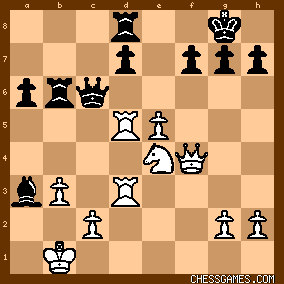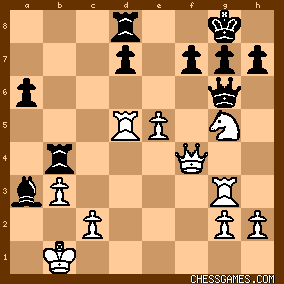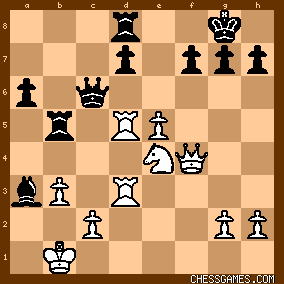|
< Earlier Kibitzing · PAGE 2 OF 2 ·
Later Kibitzing> |
| Mar-08-17 | | morfishine: <29.Nf6+>
***** |
|
| Mar-08-17 | | saturn2: <gofer Black's threats are minimal> Rb5xRd5 is a serious threat, at least more serious than Rc8 |
|
Mar-08-17
 | | Dionysius1: Reassure me somebody! Now that we all have access to analysis engines (there's a free one at https://www.chess.com/analysis-boar... ), there seems very little point in posting lines of analysis here. So why do we do it? There must be some point, but the only one I can see would be to illustrate some independent thinking or a particularly nice position from engine analysis (we could use a pgn generated diagram) Long lines of analysis on these threads doesn't really work for me without diagrams because I can't imagine a sequence of more than about 5 or 6 moves. What have I misunderstood? |
|
| Mar-08-17 | | thegoodanarchist: I found 29.Nf6+ but wasn't sure what White should play on move 30. My darn chess skills have gone down hill since I quit playing in tournaments. And quit studying tactics. And quit playing over GM games two hours a day. And quit reading chess books. |
|
| Mar-08-17 | | zb2cr: I went for 29. Nf6+, gxf6; 30. Rg3+. |
|
| Mar-08-17 | | morfishine: <thegoodanarchist> Just don't quit ***** |
|
| Mar-08-17 | | agb2002: White has a knight for a bishop.
Black threatens Rxd5. Another possibility is Rxb3+ if a rook does not protect b3 and the queen ceases to control c1. The first idea that comes to mind is the typical 29.Nf6+: A) 29... gxf6 30.Rg3+ (30.exf6 Kh8 unclear)
A.1) 30... Kf8 31.exf6
A.1.a) 31... Q(R)xd5 32.Qh6+ Ke8 33.Rg8+ Bf8 34.Q(R)xf8#. A.1.b) 31... Ke8 32.Re3+ Qe6 (32... Kf8 33.Qh6+ Kg8 34.Qg7#) 33.Rxe6+ dxe6 (33... fxe6 34.Qxh7 R(e)xd5? 35.Qg8+ Bf8 36.Qg6#) 34.Rxd8+ Kxd8 35.Qxh7 + - [Q+2P vs R+B], followed by a kingside pawn roll. A.1.c) 31... d6 32.Rxb5 (32.Re3 Rxb3+ 33.Rxb3 -33.cxb3 Qc1+ 34.Ka2 Qb2#- 33... Qxd5 unclear) 32... axb5 (32... Qxb5 33.Re3 also) 33.Re3 Qxg2 34.Qh6+ Kg8 35.Rg3+ Qxg3 36.hxg3 and 37.Qg7#. A.2) 30... Kh8 31.Rd6 Rxb3+ 32.bxc3 Qc1+ 33.Qxc1 Bxc1 34.Kxf1 + - [R]. B) 29... Kf8 30.Nxd7+
B.1) 30... Ke(g)8 31.Nf6+ followed Rxd8 wins decisive material. B.2) 30... Ke7 31.Qg5+ looks crushing.
B.3) 30... Rxd7 31.Rxd7 + - [R+P vs B].
C) 29... Kh8 30.Rh3
C.1) 30... h6 31.Rxh6+ gxh6 32.Qxh6#.
C.2) 30... gxf6 31.Qh6
C.2.a) 31... Kg8 32.Rg3+ Kh8 33.Qg7#.
C.2.b) 31... Rxb3+ 32.cxb3 as in A.2. |
|
| Mar-08-17 | | drollere: <Now that we all have access to analysis engines, there seems very little point in posting lines of analysis here. So why do we do it?> i'd guess many readers haven't bothered to acquire a chess engine, or having one can't be bothered to use it to solve a chess puzzle; and an engine won't explain the tactical mechanics of a combination, the similarities to other games, insight on how the position got so bad for one player and so forth. it's heartening to see the same avatars posting the same quality analysis, day after day; in particular the posters who admit they didn't get the puzzle or went off in the wrong direction, and explain why. it's a minor thing, but evidence of human humility and honesty is always gratifying. substantive comment aside, there's also the bystander amusement of a flame war about the greatness of morphy, the superiority of fischer, the decline of carlsen or the callowness of karjakin. finally there's the mellow satisfaction of knowing that those who post nonsense and trolling have been consigned to the Hell of Ignore where their senseless blather cannot disturb the angels of kibitz. |
|
| Mar-08-17 | | transpose: I like when others post analysis because I do not use an engine and it helps me check my own work. But I rarely post my own analysis as it take too much time. Alas, I am a free rider. On this one, I got Nf6 but missed the followup Rd6. I had mistakenly thought white wins after ...gxNf6 ef, when black can move his bishop to f8 and defend the weak g7 square. |
|
| Mar-08-17 | | Jack Kerouac: <the goodanarchist> Been there; stopped doing that. |
|
Mar-08-17
 | | Fusilli: <Whitehat1963: What's best play if 30...Bxd6?> What I see there is 31.Rg3+ Kf8 32.Qh6+ Ke7 33.Qxf6+ Kf8 34.exd6 and white is threatening four mates (Qe7#, Qh8#, Qg7+ followed by mate and Qh6+ followed by mate). I suppose there is no defense. (I'm not moving the pieces or checking an engine. Maybe there's something better.) |
|
Mar-08-17
 | | tamar: I got Rd6, but on the wrong move. Totally overlooked the bishop on a3. Have to print out <thegoodanarchist> classic post and get back into training <My darn chess skills have gone down hill since I quit playing in tournaments. And quit studying tactics. And quit playing over GM games two hours a day. And quit reading chess books.> |
|
| Mar-08-17 | | BOSTER: < Dionysius1:I can't imagine a sequence of move than about 5 or 6 moves>.
Lombardy once claim that enough to see only 2 and half moves ahead. |
|
| Mar-08-17 | | stst: At a glance, first stroke is (A) 29.Nf6+
Then other choices pop up: quiet (B)Qg5 waiting for QxR attacking back rank, cognizant that both b8 and e8 are guarded.
(C)R-sac doesn't seem the worth
(D)Pe6 advance stopped at once, either QxP or dxPFurther analyses for (A)/(B) warranted, but trust they got enough thrust thru. |
|
| Mar-08-17 | | Carlos0012358: I'm unclear as to why white played 30.Rd6, rather than 30.Rg3+. He's way ahead in any case but I would think a 2700 should know better. |
|
| Mar-08-17 | | stst: <I like when others post analysis because I do not use an engine and it helps me check my own work. But I rarely post my own analysis as it take too much time. Alas, I am a free rider. > Be a fee poster as well!!
However, suggestion to CG: Current format could be improved to the sequence of events when a reader wishes to post his/her kibitz:
Confirm posting first without being brought to the playground when one can see other's kibitz. And when brought there, the posting is already there - no peeking would help. But of course, one can always correct oneself, or add another post for better moves/analyses.
Of course, for the fully honest poster, all this won't matter. |
|
| Mar-08-17 | | stst: <30.Rd6, rather than 30.Rg3+> Yup, agreed with 30.Rg3+ prior to Rd6. |
|
| Mar-08-17 | | YouRang: <stst: <30.Rd6, rather than 30.Rg3+>
Yup, agreed with 30.Rg3+ prior to Rd6.> Yes, 30.Rg3+ seemed more natural to me also. However, it's hard to argue against the effectiveness of 30.Rd6 since it practically forces black to surrender the queen. Resignation is the correct response in either case. :-) |
|
| Mar-08-17 | | Geronimo: Oh, that's a pretty move: 30.Rd6 is just beautiful. |
|
| Mar-08-17 | | morfishine: <drollere> Its an unwritten rule that one is to solve the puzzle purely with visualization [ie: no engine] Thats the way I've always approached the POTD (with a view to improving OTB skills, which is, after all, what chess is all about IMHO) ***** |
|
| Mar-08-17 | | BOSTER: Move 23...rb6 was too timid to be correct.
Better to play a5 and then a4 to open the white king. |
|
| Mar-08-17 | | swclark25: I'm also having trouble seeing the advantage of 30)Rd6 to 30)Rg3+
I tried to follow <gofer> analysis, but didn't see explanation of <Hmmm, okay playing Rd6 on move 30 is a lot neater...> |
|
| Mar-08-17 | | Cheapo by the Dozen: Ack. When examining what turns out to be the game line, I overlooked that it was one in which 31 Qxf6 was actually playable. I was looking at 31 ef instead, which is more problematic. |
|
| Mar-08-17 | | BOSTER: I'd play 30.Rg3+.
30.Rd6 is more complicated. |
|
| Mar-08-17 | | YouRang: In the three moves prior to the puzzle position (29.?), white dropped some hints about what he was scheming: (1) <26.R1d3> lifts the rook to where it could slide over to the kingside. (2) <27.e5> providing critical support for both f6 and d6. (3) <28.Ne4> in checking range of black K via f6. This left black facing this position on his 28th move:

click for larger view
Had he picked up the hints that white had dropped, he should have played 28...Qe6!, putting the queen where it couldn't be blocked out from defense of the K via Rd6. 29.Nf6+ is no good now. Probably the best white has is 20.Ng5 Qg6 30.Rg3 Rb4!

click for larger view
White has either back off the queen, or go for exchanges, e.g. 31.Qxf7+ Qxf7 32.Nxf7 Kxf7 33.Ra5 Ra8 34.Rxa3 and winning chances are tough. ~~~~
However, black missed the hints, and played <28...Rb5?>

click for larger view
This is the puzzle position solved with <29.Nf6+!> (although 29.Rxb5 also looks winning for white). |
|
 |
|
< Earlier Kibitzing · PAGE 2 OF 2 ·
Later Kibitzing> |





